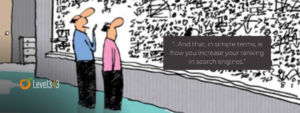SEO is something a lot of businesses will need to invest in. However, understanding individual costs and their impact on return on investment can be confusing. With so many variables involved in SEO strategy, knowing whether you’re spending over the odds in a particular area can prove difficult. Below, we’ve outlined 10 of the biggest SEO costs you’ll want to consider.
1. SEO Tools and Premium Software
Optimization tools and software are no longer cost-prohibitive. Nowadays, a huge variety of free-to-use tools can be readily downloaded and put to work immediately. Even premium alternatives are relatively affordable.
For small businesses looking to leverage SEO effectively, free SEO tools are worth investigating. However, although they provide a good introduction to the fundamentals, free-to-use solutions are often limited when it comes to features.
Ultimately, businesses will need to pursue paid alternatives. However, it’s easy to pay for more SEO tools than you need. Many solutions provide similar services. If you’re looking to tackle overspending, outline your objectives and identify which tools are required.
2. Hiring SEO Specialists
Investing in paid SEO specialists has its advantages. Utilizing third-party providers tends to be more cost-effective. Establishing an in-house team can make sense for larger organizations, but smaller businesses will struggle to realize a viable ROI in your SEO.
Unless you’re undertaking a particularly active SEO strategy, an in-house team is likely to be sitting idle a lot of the time. Using an external SEO provider means you’re only paying for the services you use.
There are other benefits to using an SEO agency. For starters, they are likely to have broad experience working across multiple industry sectors. This makes them particularly adaptable.
Furthermore, they tend to be fully versed in the latest SEO and content marketing trends, allowing them to tailor your campaigns accordingly.
3. Investing in User Experience Design
Another SEO cost you’re going to have to account for is refining the user experience credentials of your website. This is particularly important if you’re looking to increase conversions.
In short, user experience involves fine-tuning your website to make it more accommodating for visitors. The main goal here is to encourage a user to make a purchase or choose your services. However, it can also help lead generation efforts.
Depending on the scope of the work required, user experience design can be expensive. Site navigation and page-loading speeds need to be considered. With more than 54 percent of all website traffic generated from mobile devices, it’s also vital that your platform is mobile-friendly.
4. Technical Audits and Development Fixes
If you’ve chosen to hire an SEO specialist, the first thing they’re likely to do is to carry out a technical audit of your site. This will flag any major errors that can quickly be resolved. The cost of these audits can’t be avoided.
There’s no point investing in content creation and on-page SEO strategy if technical gremlins aren’t addressed. Sometimes, the services of web developers and IT professionals may be called for.
5. Creating High-Quality Content
The cost of quality content is often overlooked. However, premium content is a vital part of any effective SEO strategy. If you fail to invest in high-quality content, you’ll be severely limiting your organic SEO efforts.
Remember, search engines look favorably on websites rich in relevant content that’s up-to-date and quoted from reliable sources. Smaller businesses can minimize expenditure by arranging for the copy to be produced in-house.
However, outsourcing content creation to a professional is something to consider accommodating for in your SEO budget.
6. Premium Imagery
Here’s another content cost that can impact your SEO return on investment. Every website is going to require a great deal of unique imagery. If you’re choosing to produce this internally, you’ll need to budget for a photographer and post-production services.
Alternatively, you can utilize a stock imagery service. To avoid the spiraling costs of purchasing imagery on an ad hoc basis, opt for a subscription service instead.
7. Local SEO Strategies
You must think about local SEO when outlining your optimization strategy. For smaller businesses, local search optimization should be tackled quickly and affordably.
However, you need to be mindful of hidden costs like advertising and service subscriptions. If your business occupies a particularly competitive industry, local SEO can prove an expensive venture.
8. Website Heatmap Tools
Investing in heatmap tools is something to consider. If you want to monitor the behavior of visitors to your site, heatmaps are an invaluable resource. However, if you’re looking to get the best ROI in your SEO efforts, tread carefully.
In short, a heatmap will let you see how users are interacting with different parts of your web pages. Nowadays, there are several different types of heatmap tools you can put to use. All of them can provide valuable insights, but if you want to manage ROI in SEO, some are more useful than others.
Click Heatmaps and Scroll Maps
Click heatmaps to keep things simple. These user-friendly tools let you see what interactive elements your site visitors are actually using. This can include site navigation, CTA elements, as well as internal links.
Scroll maps are another handy heatmap tool worth investing in. These let you know how far users have scrolled down any given page before leaving it. If your pages have long columns of text or you’re operating an eCommerce platform, scroll maps are a must.
If the lower stretches of your pages are cooler in color, take this as a sign that your content needs optimizing. Scroll maps aren’t always a standard feature of basic heatmap tools, so may require a more significant outlay. However, you can expect a marked ROI in SEO for a relatively small investment.
Move Maps and Eye-Tracking Tools
We’ve already talked about the importance of making your site mobile-friendly. When it comes to testing your success on mobile platforms, move maps are a useful tool. These tools let you see what content is drawing the attention of your user and what parts of a page they’re spending the most time on.
Finally, you can explore eye-tracking tools. This is a fairly advanced option, so may limit your ROI in SEO. However, if you’re eager to get to the root of user behavior, it’s the only way to go. Effectively, eye-tracking tools utilize webcams to track the eye movement of your visitors. You can use eye-tracking findings alongside move map data to get a clear idea of what site content is working and what isn’t.
9. Plagiarism Checkers and Duplicate Content
Unique content should be at the heart of any SEO campaign. However, larger websites can struggle to deliver distinct content all the time. If you’re managing an expanding eCommerce empire, do you really have time to manually check every product description is as unique as it can be?
If you’re depending on third-party content creators, the need to monitor for duplicate content is even more important. Furthermore, you’ll want to ensure your own content is being lifted and used elsewhere. Thankfully, there’s no shortage of plagiarism checkers out there.
Plagiarism checkers can be used freely, but they’re not the most practical of tools. Ideally, you’ll want something that automates the process of checking pages on a regular basis. Some plans operate on a price-per-page model. Others may offer batch searches for a fixed monthly fee. Prices will vary, but even premium plans are relatively affordable.
10. Other SEO Costs You May Encounter
Even once you’ve plowed significant capital into website design and SEO strategy, you’ll still need to continue investing to secure a good return on your investment. Testing tools are something you’ll want to explore to monitor things like user interaction.
Final Thoughts
Ensuring an ROI in your SEO costs can seem overwhelming at first. However, it’s worth getting a handle on them and identifying hidden costs ahead of time so you can effectively measure the return on your investment. Remember the cost of search engine optimization, is always something we grapple with. Although it’s tempting to organize in-house solutions, many businesses find it far more cost-effective to utilize the services of third-party providers.






































